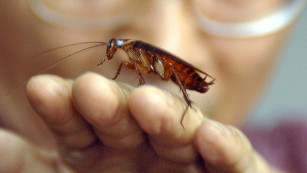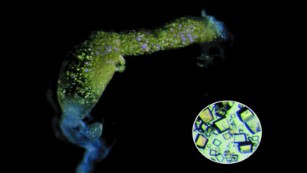(CNN)A
little cockroach milk with those cookies? Chock full of protein, the
insect milk may someday be transformed into a food supplement worthy of
human consumption, new research indicates.
Scientist have found that the Pacific Beetle Cockroach feeds its bug babies a formula which is remarkably rich in protein, fat and sugar.
Don't expect to find it next to the regular milk in the dairy section, however, at least not for now.
"Any
liquid harvested from a cockroach is not true milk. At least not as we
think of it," said Becky Facer, director of school and educator programs
at Fernbank Museum of Natural History in Atlanta.
Most people would agree. After all, the insect liquid takes the form of protein crystals in the guts of baby cockroaches.
"The
protein crystals are milk for the cockroach infant. It is important for
its growth and development," said Leonard Chavas, one of the scientists
behind the research. He explained the crystals have a whopping three
times the energy of an equivalent mass of buffalo milk, about four times
the equivalent of cow's milk.
"The
interest here was, what is it really made of?" said Chavas, one of the
authors of the research, published in July in the journal International
Union of Crystallography.
Chavas
and his colleagues examined the species, also known as Diploptera
punctata, which is the only species of cockroach known to be viviparous
-- able to bring forth live babies that have developed within the
mother's body, instead of the mother laying eggs to develop outside her
body.
Like other viviparous
creatures, this species of roach nourishes its growing embryos with a
protein-rich liquid secreted by its brood sac -- the roach version of a
uterus.
Soon
after the embryo ingests the liquid, protein crystals develop within
its midgut. Chavas and his colleagues extracted one of these crystals to
learn more about it and its potential nutrition. Following tests and
even genome sequencing, they discovered it was a complete food.
"It
is what one would need: protein, essential amino acids, lipids and
sugars," Chavas said, explaining that the energy content is so high that
it helps infants within this unique species grow much bigger than
cockroach babies of other species.
Though
the crystal formation may seem surprising, other crystals, including
insulin, take shape within the body for easier bodily storage -- and it
could have potential for human consumption, the research suggests.
So, how do you milk a cockroach?
The
crystals are currently extracted from the midgut of cockroach embryos
-- perhaps not the most efficient way of feeding a growing world
population.
Ultimately, however,
Chavas and his team are hoping to reverse bioengineer cockroach milk,
but first they need to understand the exact biological and chemical
mechanisms underlying the process.
"For
now, we are trying to understand how to control this phenomena in a
much easier way, to bring it to mass production," Chavas said.
Having
lost a drinking game with his colleagues, Chavas tasted the cockroach
milk once. "No particular taste," he commented, though the idea of ice
cream appeals to him. He imagines "a flavor with honey and crispy
pieces."
Laugh as you may, there
is no irony lost on the fact that that this insect that can survive a
nuclear disaster may someday provide the ultimate liquid superfood.


No comments:
Post a Comment